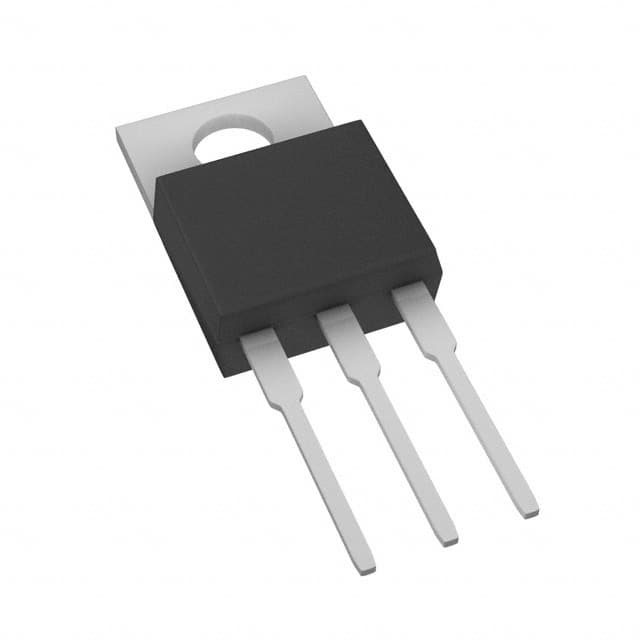Viz Specifikace pro podrobnosti o produktu.

MBR10H150CT-E3/45
Introduction
The MBR10H150CT-E3/45 is a high-performance Schottky rectifier diode designed for various electronic applications. This entry provides an in-depth overview of the product, including its category, use, characteristics, package, specifications, pin configuration, functional features, advantages and disadvantages, working principles, application field plans, and alternative models.
Product Overview
- Category: Semiconductor/Electronic Component
- Use: Rectification in power supply circuits, voltage clamping, and freewheeling diode applications
- Characteristics: High current capability, low forward voltage drop, fast switching speed
- Package: TO-220AB
- Essence: High-efficiency rectification and voltage regulation
- Packaging/Quantity: Available in tape and reel packaging, quantity varies by supplier
Specifications
- Voltage Rating: 150V
- Current Rating: 10A
- Forward Voltage Drop: Typically 0.75V at 5A
- Reverse Leakage Current: Maximum 50µA at 150V
- Operating Temperature Range: -65°C to +175°C
- Storage Temperature Range: -65°C to +175°C
Detailed Pin Configuration
The MBR10H150CT-E3/45 has a standard TO-220AB package with three pins: 1. Pin 1: Anode (Positive terminal) 2. Pin 2: Cathode (Negative terminal) 3. Pin 3: Thermal pad (Connected to the metal tab for heat dissipation)
Functional Features
- High current carrying capability
- Low forward voltage drop for reduced power loss
- Fast reverse recovery time for efficient switching
Advantages and Disadvantages
Advantages
- High efficiency and reliability
- Suitable for high-frequency applications
- Compact and robust package design
Disadvantages
- Higher cost compared to standard silicon diodes
- Sensitive to voltage spikes and overcurrent conditions
Working Principles
The MBR10H150CT-E3/45 operates based on the Schottky barrier principle, where the metal-semiconductor junction allows for faster switching and lower forward voltage drop compared to conventional PN-junction diodes. When forward-biased, it conducts current with minimal voltage drop, making it ideal for high-frequency and high-efficiency applications.
Detailed Application Field Plans
The MBR10H150CT-E3/45 is commonly used in the following applications: - Switch-mode power supplies - DC-DC converters - Solar inverters - Motor drives - Uninterruptible power supplies (UPS)
Detailed and Complete Alternative Models
- MBR10H150CT-E3/8: Similar specifications with different packaging
- MBR10H150CT-E3/51: Higher voltage rating variant
- MBR10H150CT-E3/73: Lower forward voltage drop variant
In conclusion, the MBR10H150CT-E3/45 is a high-performance Schottky rectifier diode with versatile applications in power electronics and voltage regulation. Its advanced characteristics and reliable performance make it a preferred choice for demanding electronic designs.
Word Count: 443
Seznam 10 běžných otázek a odpovědí souvisejících s aplikací MBR10H150CT-E3/45 v technických řešeních
What is the MBR10H150CT-E3/45 diode used for?
- The MBR10H150CT-E3/45 diode is commonly used in power supply and rectification applications due to its high efficiency and low forward voltage drop.
What are the key specifications of the MBR10H150CT-E3/45 diode?
- The MBR10H150CT-E3/45 is a 150V, 10A Schottky diode with a low forward voltage drop and fast switching characteristics.
Can the MBR10H150CT-E3/45 be used in high-frequency applications?
- Yes, the MBR10H150CT-E3/45 diode is suitable for high-frequency applications due to its fast switching speed and low reverse recovery time.
How does the MBR10H150CT-E3/45 diode compare to other similar diodes in terms of performance?
- The MBR10H150CT-E3/45 offers superior efficiency and lower forward voltage drop compared to many standard diodes, making it ideal for power-sensitive applications.
What are the typical applications of the MBR10H150CT-E3/45 diode?
- Typical applications include switch-mode power supplies, freewheeling diodes, OR-ing diodes, and reverse battery protection circuits.
Is the MBR10H150CT-E3/45 suitable for automotive applications?
- Yes, the MBR10H150CT-E3/45 diode is often used in automotive electronics due to its rugged construction and high reliability.
Does the MBR10H150CT-E3/45 require a heatsink for operation?
- The need for a heatsink depends on the specific application and operating conditions. In high-power or continuous operation, a heatsink may be recommended.
What are the temperature ratings for the MBR10H150CT-E3/45 diode?
- The MBR10H150CT-E3/45 diode is typically rated for operation over a wide temperature range, with a maximum junction temperature specified by the manufacturer.
Are there any common failure modes associated with the MBR10H150CT-E3/45 diode?
- Common failure modes include thermal overstress, reverse voltage breakdown, and excessive current leading to junction damage.
Where can I find detailed application notes and reference designs for using the MBR10H150CT-E3/45 diode in technical solutions?
- Detailed application notes and reference designs can often be found in the datasheet provided by the manufacturer, as well as in application-specific technical literature and online resources.

